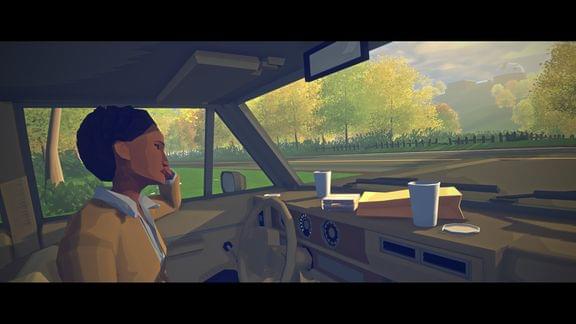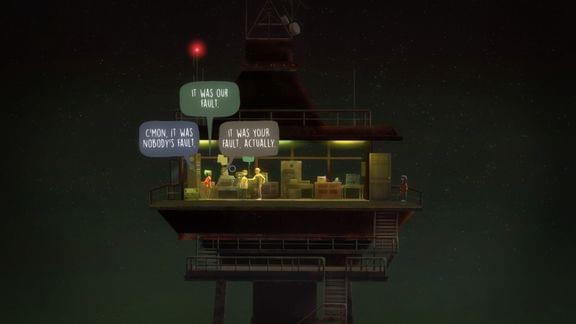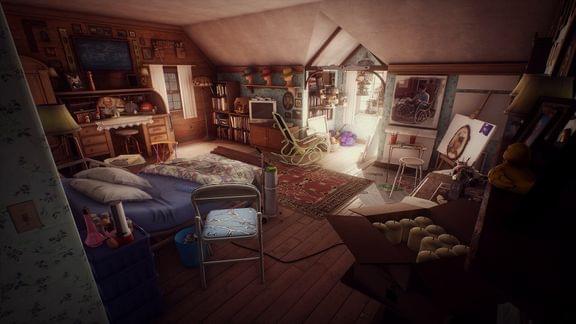Previously few years ago I listed some games that I had enjoyed in the exploration game genre usually mockingly called “walking simulators”. Between then and now, the genre has expanded with more games and more experimentation. So, here’s a list of games that I have enjoyed since.
Dr. Langeskov, The Tiger, and The Terribly Cursed Emerald: A Whirlwind Heist (2015)

Where many walking simulators are worlds created for the player and the player’s progression triggers what happens in the game, this game looks at what happens - literally - behind the scenes. It is a game about a game about a heist.
Another aspect of this game is that it is light-hearted and fun. Comedy is notoriously difficult genre in games due to their interactive form that renders timing and pacing near impossible. However, many of the adventure games have been very humorous in nature1 and it is refreshing that not all “walking simulators” go for deeper, darker themes or even horror.
Suffice to say, the creator of Dr. Langeskov etc. worked on the remastered version of The Stanley Parable.
This is a free game, and very short2 - unlike its title. It’s also one of those games it’s best to go in without knowing too much. This is a game you want to go and play.
Everybody’s Gone to the Rapture (2015)

From the creators of Dear Esther, the game that arugably started this genre.
Unfortunately, Everybody’s Gone to the Rapture doesn’t really advance the genre. Very much like Dear Esther, it is a pure exploration game where you follow a path and narration kicks in at certain points. The story could, very possibly, work as well as an audiobook.
Fortunately, the story is not as vague this time around and there’s more to look at. The game does a great job of recreating a British countryside town with a lot of detail but this also highlights the common downsides to the genre: everything feels empty and static - even though in this game that is an essential part of the story.
The Beginner’s Guide (2015)

The follow-up game from the creator of The Stanley Parable, which fortunately has very little to do with the previous game except by using Source SDK as the engine.
The game is (seemingly) a retrospective of the experimental games left behind by a recluse artist/programmer. These games were recovered by the game’s narrator who has collected them and guides the player through these creations while explaining how they came to be.
While the game might take things way too meta for many, one interesting addition to the genre is that the narrator might be unreliable and downplaying his mistakes. This is a bit different from The Stanley Parable’s narrator, because here the narrator might be embellishing the story at the same time as being imprevious to the story the games are trying to tell and his role in them. As the description of the game tells,
[The game] tells the story of a person struggling to deal with something they do not understand.
Too many games in this genre attempt to copy from teleivision and movies their story-telling and game is secondary to the narration. This is not one of them.
Virginia (2016)

Virginia received a lot of hype, because it looks gorgeous and has a unique cinematic feel unlike other games. What sets Virginia apart from the other games is that it tries to solve the pacing problem of the genre by transition from cut to cut. The game borrows from movies and especially from Twin Peaks.
Somehow, the magical realism of small-town America seems to speak to many creators of these games. Maybe it comes from movies and TV series like Twin Peaks, Fargo and such. Maybe this recurring motif appeals to the designers because it allows them to create a small self-contained place where time stands still, yet everything is possible.
Like most indie adventure games, Virginia does not have any dialogue and so tries to use lack of it as a story-telling device. However, the vagueness as a stylistic choice also easily leaves the player guessing what happens or what they are doing in the first place. This genre usually doesn’t let players interact too much and so few have a narrative around the player, leaving the player to observe the world and its actors and creating their own story. However, in Virginia you play as the main character who does things and to whom things happen - yet as a game on rails, the player does not have much agency except moving forward. The game does not let the player wander and explore in this game, but wants to keep its pacing.
A beautiful yet ultimately flawed game. Probably not a good starting point, but recommended to the fans of the genre.
Obduction (2016)

The obligatory puzzle game from arguably the creators of the genre. Conceived as a Kickstarter project, Obduction follows the path of Myst in everything except the name.
The game feels familiar yet world feels very foreign. This is a good thing, because the game is very much about exploring and looking at the world(s) around you. Like other games from Cyan, you’re left to piece together the story and the world around you with its languages, codes and puzzles.
Even though the game is a puzzle game, the amount of walking around qualifies it for this list.
Oxenfree (2016)

The game uses the dialogue system familiar from Telltale’s games, you have a short window to choose a line or you’ll remain silent. As such, it’s closer to Telltale adventure games than walking simulators - especially as unlike the other games in this list, this game is in 2D.
But there’s so much walking. And there are not puzzles. This really becomes a problem in the second half of the game, when it’s mostly about traversing the world with nothing else really happening. The pacing really suffers at points because of this - not really great for a game that tries to build up suspense and horror of the supernatural.
However, the game is good because it’s different - it is not as much story-driven as dialogue-driven. Where other games stop while the characters talk with each other, here the talking is integral part of the gameplay.
Californium (2016)

A game heavily influenced by Philip K. Dick’s stories and the man himself. The protagonist is a writer very much like Dick living in a world that reveals itself to be in themes familiar in many of Dick’s books - paranoia, separate realities, dystopias, Mars, and questioning self.
This game can be really frustrating because it’s mechanic is based on looking at things from the correct angle to reveal symbols. That is pretty much it for actual gameplay.
The game is definitely weird but a bit repetitive and can’t really be recommended to people unfamiliar with PKD’s works.
What Remains of Edith Finch (2017)

A game by the creators of The Unfinished Swan3, a curious puzzle game about painting the world. Edith Finch however is a pure walking simulator with a story it wants to tell you as you progress the world.
The story of going back to your childhood home might give someone vibes of Gone Home but this game rises above many others through the vignettes that tell the fates of each of the Finches in a new way.
In my opinion, the ending does not really live up to the build-up. However, in this genre, it’s so much about the journey and the experience that it doesn’t matter that much. The game tells its story and leaves it simmer with the player - how the things we love consume us in the end. It’s an entirely different thing if the player agrees with this. However, it’s a sign of a good story if it makes you think life, the universe and everything.
Kentucky Route Zero (2013 - 2018?)

A game that will finally this year see its conclusion. It began in 2011 as a Kickstarter project that saw its episodic Acts come out at irregular intervals.
Kentucky Route Zero takes that American middle-of-nowhere magical realism and pumps it to the surreal max. The game, at least by the penultimate Act, is not as much about a story but about themes and characters with different backgrounds interacting. The scenes are meant to be taken in, and the game does not allow the player to rush anything - and what would you even try to rush because at times it seems the interactivity is there to masquerade that the scene is actually about the dialogue between the characters. Did your choices even matter?4
With a distinct style and athmosphere, the game takes you on a ride where each minute of gameplay is crafted and designed.
Where many other games spend a lot of effor to build a facsimile world around the player, Kentucky Route Zero eschews all that and tries to build an experience and a world in all but the visual sense - but not without a unique style.
Notable mentions that are not walking simulators
Games not listed here because they are (point-and-click) adventure games:
- The Silent Age
- Thimbleweed Park
- Life is Strange
Games that are not listed because they are platformers:
- LIMBO
- INSIDE
- Thomas Was Alone
However, these games share a lot of similarities, in theme or execution to other games, fitting somewhere between the spectrum of genres.